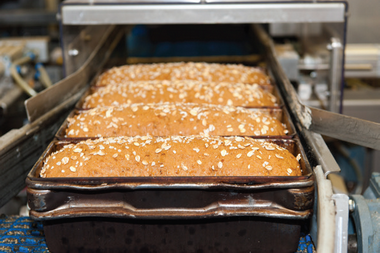


食品级润滑油的优点
我的问题是关于在封闭的螺旋齿轮和螺旋锥齿轮上使用食品级润滑油,主要是喷溅润滑。通常情况下,我们指定ISO 220 EP润滑油用于此类应用。不过,我知道,食品级润滑油通常不含有硫-磷基EP组分。PAO/SHC或PAG食品级润滑油比单纯白矿物油有什么有点呢?就抗氧化、抗磨、耐擦伤或抗乳化方面而言有哪些优势呢?
食品级,我假设你是指H1——可以与食品偶然接触的油品。在这种情况下,要求油品只能含有FDA授权许可食品安全化合物清单中的添加剂。一般情况下,H1润滑剂以聚α-烯烃(PAO)、聚亚烷基二醇(PAG)或白矿物油作为基础油调制而成。你是正确的,常见的应用于工业齿轮油中的硫-磷化学品不符合H1要求。
H2润滑剂,用于润滑剂或润滑表面没有任何与食品接触可能的设备和机械部件上面。这些化合物可以作为封闭系统中的设备和机械部件的润滑剂、脱模剂或防锈膜,而润滑剂或润滑部件与可食用产品没有接触的可能。
H3润滑剂,又称可溶性或食用油,用于吊钩、拉杆和类似设备的清洁和防锈。
作为齿轮箱供应商,当然是需要在高负荷条件(边界条件)下的充分润滑的能力。精选的H1润滑剂满足所需的性能(OK载荷、四球磨损和焊接点、FZG齿轮测试等),应该能够表现的令人满意。
在抗氧化方面,合成油(PAO、PAG等等)可以比矿物油表现的稍微好一点,而高度精炼性质意味着白油具有接近合成油的长期氧化稳定性。
同样,白油和PAO合成油一般在抗乳化方面也优于矿物油(添加剂组分没有主要差别时,也会影响抗乳化性),因为它们固有的“纯度”和不含极性化合物。
在食品级和非食品级之间真正的问题是成本和程度较轻的性能。一般来说,非食品级润滑剂能以较低成本提供相同或更好的性能。所以,除非使用食品级润滑剂是必要的,你可以使用传统的非食品级润滑剂产品。
原文参考:
Advantages of Food-grade Lubricants
"My question concerns the use of food-grade lubricants in enclosed helical and helical-bevel gearing that is primarily splash lubricated. Normally, we specify ISO VG 220 EP lubricants for this type of gearing. However, I understand that food-grade oils do not typically contain the sulfur-phosphorous-based EP packages. What advantages do food-grade PAO/SHC or food-grade PAG lubricants offer over straight mineral or white oils? Are there any advantages in terms of oxidation resistance, anti-wear or scuffing resistance or water demulsibility?"
By food grade, I assume that you mean H1 – an oil that may be prone to incidental contact with food. Under these circumstances, the requirement is an oil that contains only additives appearing on the Food and Drug Administration’s "approved list" for food-safe compounds. Generally, H1 lubricants are formulated with polyalphaolefin (PAO), polyalkylene glycol (PAG) or white oils as the base oil. You are correct that the common sulfur-phosphorus chemistry used in many industrial gear oils does not meet H1 requirements.
H2 lubricants are used on equipment and machine parts in locations where there is no possibility that the lubricant or lubricated surface contacts food. These compounds may be used as a lubricant, release agent or anti-rust film on equipment and machine parts or in closed systems in locations where there is no possibility of the lubricant or lubricated part contacting edible products.
H3 lubricants, also known as soluble or edible oils, are used to clean and prevent rust on hooks, trolleys and similar equipment.
As a gearbox supplier, what is required of course is the ability to adequately lubricate under high-load (boundary) conditions. Provided the H1 lubricant selected meets the required performance properties (OK load, 4-ball wear and weld, FZG, etc.), it should be able to perform acceptably.
In terms of oxidation resistance, synthetic oils (PAO, PAG, etc.) may show slightly better oxidation resistance than mineral oils, while the highly refined nature of white oils means that their long-term oxidative stability should approach that of a synthetic.
Likewise, the demulsibility of white oils and PAO synthetics will generally be better than mineral oils (not withstanding any major differences in the additive package, which can also affect demulsibility) because of their inherent "purity" and absence of polar compounds.
The real issue between food grade and non-food grade is cost, and to a lesser extent performance. Generally speaking, non-food-grade lubricants will provide the same or often better performance at a lower cost. So unless a food-grade lubricant is necessary for the intended application, you are typically better served with a "conventional" non-food-grade product.












